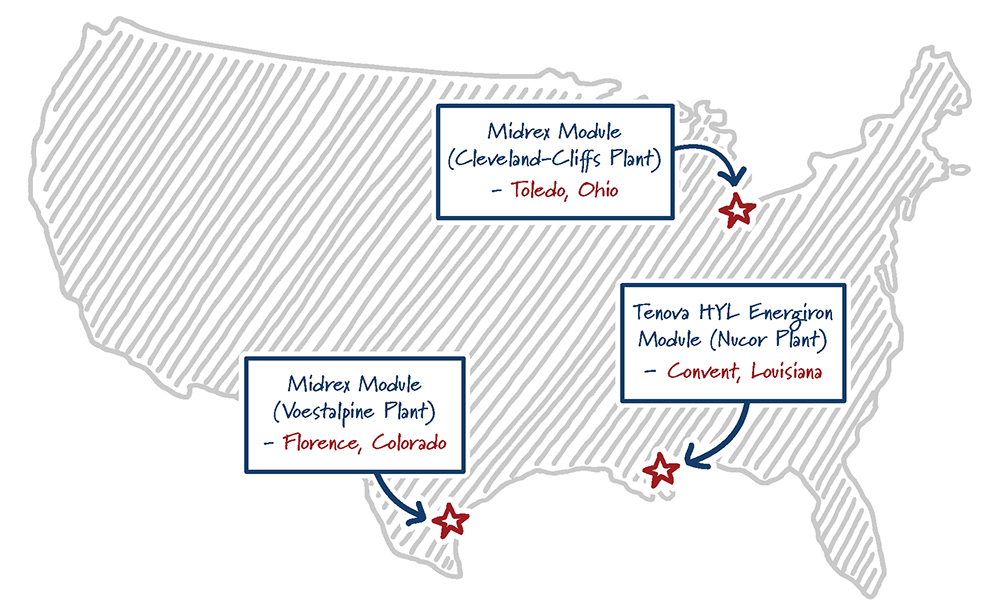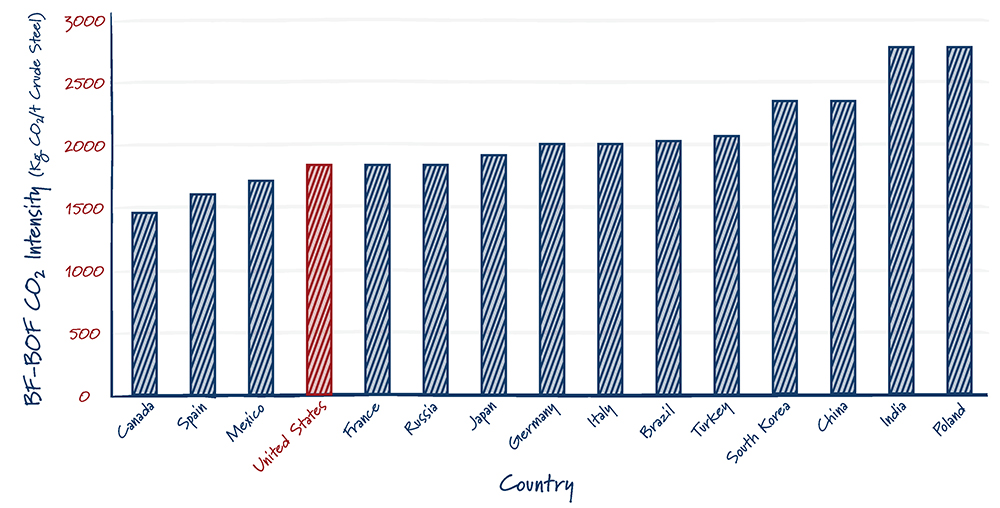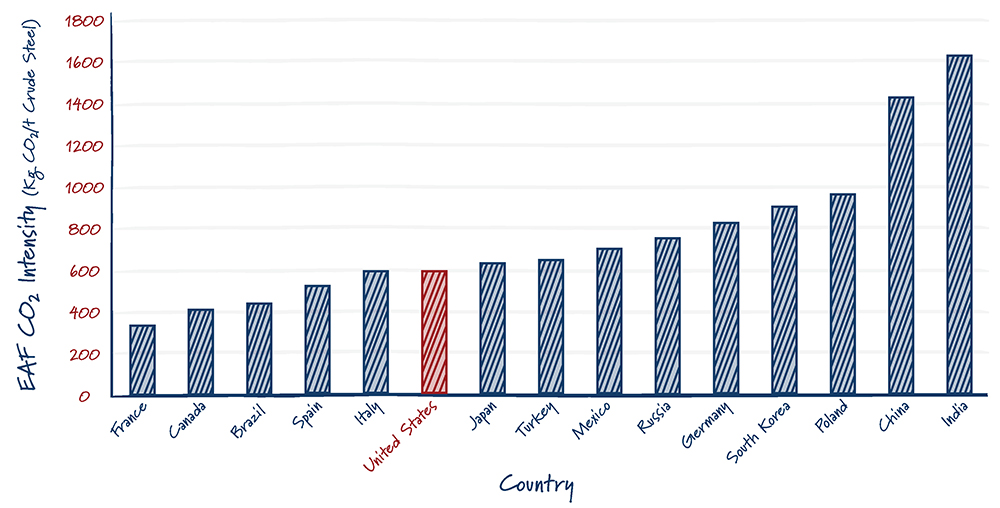Metals are an integral part of our society. Ranging from basic steels to high-performance alloys, metals are a necessary resource in transporting electricity on the grid, constructing buildings, producing everyday kitchen and household items, creating bridges and tunnels, and building trains, cars and even planes. Since metals are widely available, generally affordable, strong, and durable, they are a major component of our everyday lives.
Iron, the key ingredient in steelmaking, is the fourth most abundant element in the earth’s crust and the key ingredient used to produce steel.1 People have a long history with it too – humans have been making steel for 4,000 years and developed various types of steel despite the production process staying relatively the same.2 Although making steel requires lots of heat and historically has produced significant emissions, several new technologies promise to improve the industry’s carbon footprint. The United States’ steel industry is cleaner relative to international steel production. Chinese steel has the highest energy and carbon dioxide intensity and accounted for roughly 51 percent of global steel production in 2018.3 Despite this, within the U.S., steel production accounts for 81 percent of total overall emissions related to U.S. metals production.

Source: United States Environmental Protection Agency4

Source: Adapted from Hasanbeigi, A. and Springer, C. 2019.5
Integrated Blast Furnace (BF) and Basic Oxygen Furnace (BOF) A blast furnace is the first process in manufacturing steel from iron ore, which is mined. Blast furnaces heat purified coal, or “coke,” limestone, and iron ore, then inject it with oxygen to reduce the carbon content and remove impurities.
Electric Arc Furnace (EAF)
Electric arc furnaces produce molten steel using electrical currents to melt scrap and recycled steel instead of raw iron. On average, electric arc furnaces produce 85 percent less CO2 per ton of steel, which holds potential for cleaner steel manufacturing.6Direct Reduced Iron (DRI)
Another promising steel production method is Direct Reduced Iron (DRI) paired with electric arc furnaces. In North America, there are currently three operating direct reduced iron plants. Direct reduced iron, also sometimes referred to as “Sponge Iron,” is an alternative steel production route which uses natural gas. Direct reduced iron is transformed to steel in electric arc furnaces, essentially replacing metal scrap. This produces stronger, high-quality steel with few contaminants, which is not typically easy to make using scrap in electric arc furnaces, due to the varying quality of scrap.

The margins in the steel industry are very low, and some companies operate on losses for years before the market flips and they start seeing profits. If the U.S. is going to make a dent in steel decarbonization without driving domestic manufacturing out of business, we need to consider what’s realistic and economical. In order to do this, America needs to innovate:
1. Carbon capture retrofits. At present, there are only 11 operating blast furnace plants in the United States, and these plants account for 65 percent of yearly iron and steel emissions – roughly 47 million tons of carbon dioxide.7,8 Blast furnaces are likely to stick around due to their long lifespans and their ability to produce high-quality steel, a product that is difficult to do through electric arc furnaces. Due to their high emissions intensity and long lifetimes, blast furnaces would be great candidates for carbon capture retrofits. Retrofits have historically been cost prohibitive, in part due to intense global competition for low-cost steel. Though steel carbon capture research and development is in its early stages, the U.S. Department of Energy (DOE) has partnered with the largest steel company in the world, ArcelorMittal, to explore this pathway. The Department is also leading research to utilize captured emissions. One company out of New York City is even converting carbon emissions into vodka!
Direct reduced iron pathways would also benefit from carbon capture because it already produces a high concentration CO2 stream during production. In fact, one steel facility in the UAE is demonstrating this can be done at a commercial stage, and several technology vendors have off-the-shelf designs.
2. Conventional clean steel. Electric arc furnaces produce fewer emissions and are capable of adjusting to the ebbs and flows of demand. Additionally, because the energy source in electric arc furnaces is electricity, to clean up the steel industry, it is important that this additional electricity consumption is a reliable commercial supply of clean electricity. In the absence of high-quality steel scrap to produce high-quality steel through electric arc furnaces, an alternative is to incorporate direct reduced iron as a supplement to mix with the low-quality scrap and produce high-quality steel.
Currently, all three direct reduced iron plants in North America primarily use natural gas for steam methane reforming on-site to obtain hydrogen. However, because hydrogen is one of the key ingredients for direct reduced iron production and a cleaner alternative fuel, if created through cleaner processes such as electrolysis, there is a huge opportunity for clean steel production by integrating hydrogen. ASwedish project began construction and will use 100 percent hydrogen to produce clean steel and is targeting scaling up production by 2025.
3. Novel technologies. Any problem brings innovators itching to create new and imaginative solutions. The steel industry has done just that. One of these revolutionary new processes comes from Boston Metal9, which only uses electricity and iron ore to produce steel. Other creative processes such as flash ironmaking are also on the horizon and are being monitored and researched by the Department of Energy.
4. Efficiency. There are efficiencies that can be implemented in current steelmaking processes. A few ways this can be achieved is through innovative iron and steelmaking processes ranging from waste heat optimization, maximizing scrap recycling, and process monitoring and automation to increase operating efficiency.
Global CO2 Intensity of Blast Furnace-Basic Oxygen Furnace (BF-BOF) Steel Production in 2016

Source: Hasanbeigi, A. and Springer, C. 201910
Global CO2 Intensity of Electric Arc Furnace (EAF) Steel Production in 2016

Source: Hasanbeigi, A. and Springer, C. 201911
R&D. Despite new technologies that have emerged, R&D is still needed to review technologies that not only reduce and remove emissions but also focus on cost competitiveness, efficiency, and reducing complete life cycle emissions. A process that removes emissions without factoring potential increases in other resources needed increases overall emissions, so we may as well stick to the status quo. Researching one or a combination of the alternative pathways covered would ensure that we produce innovative and competitive solutions.
Carbon capture. If we’re looking for the solution with the largest return on investment in terms of carbon abated, it would be to implement carbon capture retrofits to all of the remaining blast furnace plants in the U.S. This could potentially remove roughly 47 million tons of CO2 emissions per year – that’s electricity for eight million homes annually. DOE’s support through cost sharing ArcelorMittal’s steel carbon capture research is a great start, but there’s still a hill to climb in deploying this technology at all blast furnace plants.
